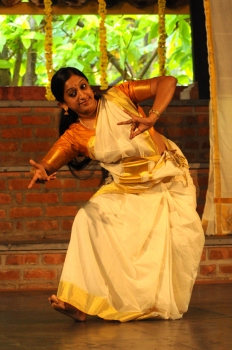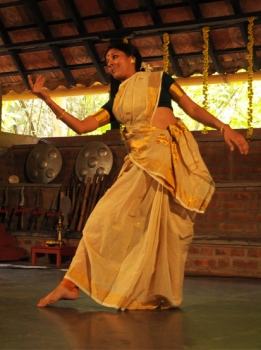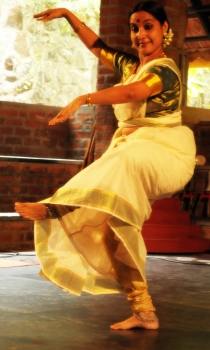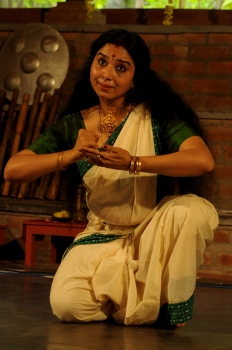
|   |

|   |
Samavesh 2011: A unique coming together of Mohiniattam practitioners - Nanditha Prabhu (Chennai) & Shruti KP (Bangalore) e-mail: prabhu.nandu@gmail.com / shruthi27@yahoo.com January 5, 2012 Like the various tributaries that meander in its own paths one day converge to become the ocean, Samavesh 2011 laid the platform for the various tributaries of the art form Mohiniattam to converge, voice their own views, share their beliefs and ideas and celebrate the art form. Young practitioners of the art form who had made a mark of their own were invited to present papers on topics of their specialization. Students, art lovers and performers present amongst the audience were equally participative and it was a joy to absorb the energy that pervaded the Spaces during the two day seminar held in the Margazhi Festival season in Chennai on 17 and 18 December 2011. The seminar witnessed talks by eminent gurus of the field: Bharati Shivaji, Dr. Neena Prasad, Vijayalakshmi, Gopika Varma, and Smitha Rajan. It also included the treat of a rare documentary on the life of dance exponent Shanta Rao. Samavesh was inaugurated at the Rabindranath hall, Kalakshetra. A quick introduction of the two day seminar was given by V R Devika, of The Aseema Trust, who co-organised the event. The documentary was the first session for the day, with a prelude by friend and biographer of Shanta Rao, Ashok Chaterjee. The audience comprised of a few students from Kalakshetra, Shanta Rao’s friends and some dancers. On the whole, the space was filled with artistic heads extremely interested in the talk and documentary. Ashok Chaterjee’s passionate prelude enlightened all about Shanta Rao as a woman, dancer, and artist. His talk included snippets from his book ‘Dances of golden Hall’ on her and was supported by the images photographed by co-author of the book, Sunil Janah. One was mesmerized by the romance of these old, rare pictures and the artist manifested on the white screen. Her dance, life and paintings all seem to be a private worship of art that was shared only with few fortunate ones while to the rest of the world she was a performer of classical dances. It was followed by a short clipping of her dancing that was documented by the international broadcast by BBC. One should thank Ashok Chaterjee as this seems to be the only treasure of Shanta Rao that is banked for future other than the photos by Sunil Janah. However, to be taken into account was the missed reaction to the clipping. Shanta Rao's dance has always been debatable and within the room of current generation there was no room for her Bamanrithyam, Mohiniattam, Kathakali, or Bharatanatyam. They hardly looked similar to what has been practiced now. Friends looked fondly, learners guffawed critically, and artistes watched objectively. The reason to open the seminar with a documentary specifically on Shanta Rao was to throw light on the first of Mohiniattam dancers and to show the journey of Mohiniattam. An incredible journey that has polished the movements and can never be called ‘the poor cousin’ of any other classical art. Mohiniattam has at last, after much work of artistes and connoisseurs developed its own individual streak. In the evening, the venue was shifted to Chandralekha’s Spaces: a comfortable place for a discourse. Shereen, the bubbly, enthusiastic youngster was the moderator and as she introduced and invited the speakers, her voice reached out to the Samavesh arena with contagious energy. The first talk was by Guru Smitha Rajan on the three aspects of abhinaya and the works of Guru Kalyanikutty Amma, her grandmother and guru. She demonstrated different sets of basic adavus as an intro to her lecture/discourse. Smitha Rajan spoke of Kalyanikutty Amma’s contributions to Mohiniattam. In her lecture demonstration she spoke of the scientific structure, adavus, kritis that ‘the mother of Mohiniattam’ had codified and choreographed. She also spoke of how genres of dance piece like Saptam can have contemporary themes and still stay within the rules for which she cited her own production ‘Jhansi Ki Rani’ as an example. She is a great guru who cleverly weaves the contemporary without harming any aspect of tradition.
Smitha Rajan not only propagates Mohiniattam but at the same time carries the sampradayam of her family by following the same structure of angika, aharya, vachika and sathvika abhinaya as established by her grandmother. She said that only by going through the three stages of abhinaya, the Sameepyam, Saroopyam and Tadatmyam can one bring out the essence of the character being portrayed and the story told effectively. She performed three pieces of abhinaya from her treasure trove to show the differences between the three types of abhinaya. The audience not only witnessed marvelous knowledge and experience but also was bewitched by her dancing skills as they asked her to perform various dance pieces which she did without any hesitation! Her talk was followed by an interactive session with Bharati Sivaji, Dr. Neena Prasad, Smitha Rajan and Vijayalakshmi on “Taking Mohiniattam forward.” Bharati Shivaji exhorted the need for a collective effort in Mohiniattam for the healthy growth of the dance form. Smitha Rajan stressed on the need for a thorough training and understanding of the dance form before plunging into performance and choreography. Dr. Neena Prasad was of the opinion that despite being a very rich dance form, Mohiniattam is probably not getting the limelight, because it needs more committed artistes with a greater vision for Mohiniattam. Vijayalakshmi said that the organisers need to think of collaborations with cultural organizations and professional art administrators in order to gain wider audience and participation. A need was felt in taking Mohiniattam to the schools, perhaps all dancers should consider it their responsibly to take the dance form closer to the younger generation making it more accessible and interesting. All the speakers were happy that Lasyatarangini (an online forum for Mohiniattam) has made such an attempt to bring the Mohiniattam community together and felt that it is a new beginning, the need of the hour.  Smitha Rajan  Vijayalakshmi Day two began with Vijayalakshmi’s session as she explored the ‘Techniques and new dimensions in Mohiniattam’ with grace. She spoke about the research and understanding of the art form by her Guru and mother Bharati Shivaji. The definition of Mohiniattam as the “dance of the enchantress or a pretty woman” according to Vijayalakshmi was incomplete: it was not only the dance of a pretty woman, but also the dance of an intelligent woman. As she demonstrated the various “chuzhipus” or body stretches and the “maiadavus” or the units of the dance, she stressed on the importance of unleashing the internal energy which lies latent in the solar plexus. “Mohiniattam which seems deceptively simple is an embodiment of lasya which should be backed by energy,” she said. Being the granddaughter of a musician, she had a good grounding in Hindustani music and to her music was the main inspiration behind all her choreographies. In ‘Unniyarcha,’ a thematic dance drama, she explored the possibilities of “Vadakkan pattukal,” the folk ballads from northern Kerala to create an ambience and enriched it with the movements of Kalaripayattu, the martial art form of Kerala. Here, she also experimented with various possibilities of aharya (costumes) within the boundaries of Kerala’s aesthetic sensibility. ‘Swan Lake,’ an artistic interpretation to the Russian classical music of Tchaikovsky was the brain child of Vijayalakshmi and she along with a Chhau dancer and a group of Mohiniattam dancers, lyrically redefined the art form. Bihari and Bengali culture were reflected in her other productions. There might be lots of if’s and but’s while we watch the style of Bharati Shivaji as our minds are conditioned, and our body and eyes are trained to a specific genre of Mohiniattam. But keeping all these aside, Vijayalakshmi seemed to be both a pretty and intelligent woman, well trained in Bharati Shivaji’s style of Mohiniattam, with an ear for music and eye for aesthetics, committed to the cause of Mohiniattam. The second paper for the day was ‘Tandava element in Mohiniattam’ by Dr. Neena Prasad. While one would pause a while on hearing the topic of the paper, Neena’s session was an eye opener. She started by referring to the earliest prevalent text on performing arts, Natyasastra by Bharatamuni which could be dated back to 1st century BC. The fourth chapter ‘Tandavalakshanam’ in the treatise gives a detailed explanation on the nritta element in performing arts. The word ‘tandava,’ like many other words in the past have been passed down through centuries only to be misinterpreted. Bharatamuni received the nuances of nritta aspect of performance from the direct disciple of Lord Shiva, Shiva Tandu. As the lessons on nritta were given out by Tandu, the nritta element came to be called Tandavam. Therefore the fourth chapter is named Tandavalakshanam. Bharata also mentions the forms of execution: the Uddhata way and the Sukumara way. The Udhata way was later translated as Tandava, while the Sukumara was later named Lasya in later centuries. All living things are endowed with male and female energies, in different permutations and combinations; similarly Mohiniattam which is predominantly a feminine dance is also capable of portraying male character. Tandava later came to mean the virile energy while lasya came to mean grace and subtlety. Her theory that both Lasya and Tandava are two contrasting colours which can be made to complement each other with the lighter shades of the respective colours when situation demands was an interesting concept. She very beautifully portrayed three male characters: one as Lord Nataraja himself executing the Tandava (nritta), then a more earthly character as King Ajatashatru in Amrapali and the pining Radha who yearns to be one with Lord Krishna and finally merges into him. Dr. Neena Prasad’s sincerity and quest as a dancer to learn about the nuances of the dance was well reflected in her lecture and demonstration.  Dr. Neena Prasad  Gopika Varma The concluding session of the series of four talks was a lecture demonstration by Gopika Varma on her ‘Approach to choreography.’ As a performer, she claimed herself to be a storyteller, an attribute which she imbibed from her grandmother who used to narrate many stories to her in her childhood. She described how each story she found worth choreographing lingered in her mind and enabled her to identify herself with the characters. Elaborate abhinaya being her strongest point in dance, she has always believed in onstage improvisation while enacting a role. She believes that more than her words and her theories, her choreography speaks for itself. With “Yamuna Kinare,” a bhajan by Maharaja Swathi Thirunal, one of her recent choreographies, she showed her creative way of weaving a beautiful story out of a few verses. She then demonstrated a Varnam in praise of Lord Ayyappan, showing how to handle multiple characters including the extreme maleness of Shiva and also handling of various rhythm patterns in Mohiniattam. Through ‘Bhama Kapalam,’ she showed how she gave two different personalities to both Satyabhama and Rukmini. Her ‘Vishweshwaradarshanam’ showcased her unique way of narrating and emoting to the audience to the point of complete involvement. Lasyarangini, the online community of Mohiniattam dancers, ably supported by Kalavartha and Aseema Trust, made Samavesh happen at the right time at the right place with the right people. Let Samavesh be a stepping stone for the art form and let it be a meeting ground for all dancers to come together, dance together, agree to disagree and thus celebrate and keep the tradition alive! Nanditha Prabhu is a Mohiniattam and Bharatanatyam dancer trained under her mother Kalamandalam Suganthi and Padma Subrahmanyam respectively. She runs her dance school Mythri Art Academy in Chennai. KP Shruthi is a freelance choreographer and performer. She is an Attakkalari graduate and learns Mohiniattam under the guidance of Guru Sreedevi Unni and Guru Nirmala Panicker. As a Mohiniattam soloist she has performed at various prestigious dance festivals. |